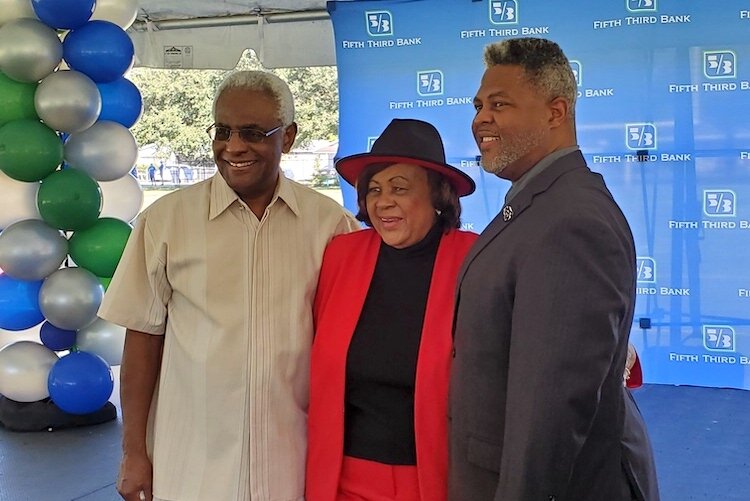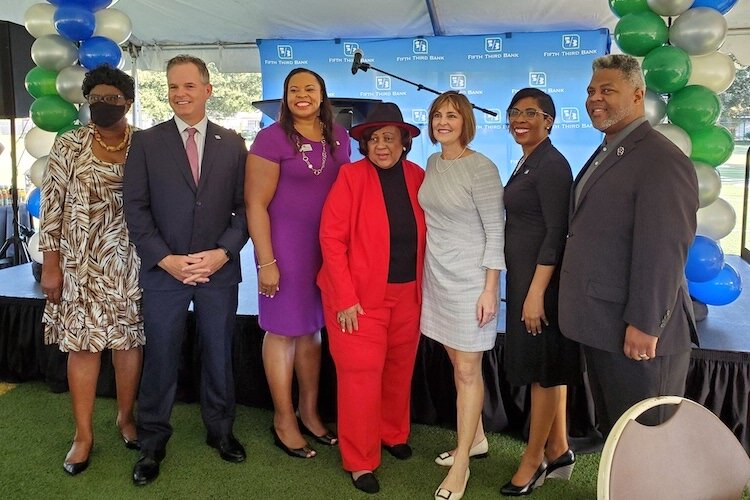Fifth Third Bank pledges $20M for East Tampa neighborhood development
East Tampa will be the beneficiary of new loans, private equity, and philanthropic support designed to close equity gaps in the historically black community.
East Tampa is a gem among the City of Tampa’s neighborhoods, deeply rooted in generational African-American history, culture, and entrepreneurial spirit.
Yet, even as other neighborhoods — Ybor City, Channelside, West Tampa, and Downtown — are thriving and growing amid the city’s economic growth, East Tampa lags.
Not for want of trying. During past city administrations brick-and-mortar infrastructure projects laid down a foundation for future growth. But a major new investment in the residents and businesses of East Tampa is giving renewed hope that Tampa finally can deliver on promises to revitalize East Tampa.
Fifth Third Bank and Enterprise Community Partners recently announced a major investment of up to $20 million over three years to redevelop East Tampa. The largely Black community will be the beneficiary of loans, private equity, and philanthropic support to transform East Tampa.
Enterprise Community Partners is a national nonprofit that will aid in developing and implementing action plans in partnership with the bank and the nonprofit Corporation to Develop Communities of Tampa, Inc., which is nearing its 30-year anniversary.
The CDC offers services, including job training, work force development, and home ownership programs, that focus on ending poverty and physical deterioration in East Tampa.
This commitment is part of a $2.8 billion pledge to provide $2.2 billion in loans; $500 million in investments; $60 million in financial accessibility; and $40 million in donations from the Fifth Third Foundation in support of the bank’s Accelerating Racial Equality, Equity, and Inclusion Initiative.
Fifth Third Bank selected nine communities in the Midwest and Southeast to share in $180 million in funds from its Neighborhood Investment Program. The dollars will aid predominately Black communities such as Avondale in Cincinnati, Ohio, and Grove Park in Atlanta. These are communities where there has been significant “disinvestment” that can benefit from infusions of funds to support “Black life and legacy,” according to a news release issued by the bank, CDC and Enterprise Community Partners.
“Our role is to serve as a catalyst to transform this (East Tampa) community over the next three to five years,” says Cary Putrino, Fifth Third’s North Florida regional president. “We want to bring the community together to create a synergy that ultimately will create jobs, more businesses, more houses including affordable housing and accessibility to financial services.”
The announcement came during a celebration on October 14 under a balloon-decorated tent on the field outside of the Jackson Heights NFL Yet Center on Lake Avenue. The Tampa Bay Buccaneers drumline opened the festivities with a spirited rhythmic beat. Dignitaries and civic leaders in attendance included Tampa Mayor Jane Castor, U.S. Rep. Kathy Castor, and Hillsborough County Commissioner Gwen Myers.
Fifth Third’s commitment comes at a critical time, according to Ernest Coney, Jr., President and CEO of the CDC of Tampa.
“One of the things that we have been really clamoring for is enterprise level capital where we can do some transformative and deep work, especially right now,” he says. “We are at a pivotal point where East Tampa will either tip one way or the other.”
East Tampa’s needs include affordable housing, economic opportunities, and a commercial base to give East Tampa a strong identity, says Coney.
“When you look at the disparities that we have, the high unemployment, the wealth gap, the income gap, this (investment) really goes toward that,” he says.
It isn’t enough to draw up good business plans when the lack of capital is the greatest barrier to East Tampa’s growth, Coney says. “The growth of East Tampa only benefits our great city.”
Fifth Third Bank established a footprint in East Tampa in 2009 when it opened a bank branch on East Hillsborough Avenue, on the outer boundary of the city of Tampa’s Community Redevelopment Area of East Tampa. The CRA is a 7-square-mile area bordered by Interstate 275, Interstate 4, and the city limits.
The CRA’s advisory board — the East Tampa Community Revitalization Partnership — works with city officials to guide decisions on East Tampa civic projects that are paid for with reinvested property taxes collected within the CRA boundaries. The projects focused by law on brick-and-mortar initiatives, not investments in home ownership or small businesses.
Putrino acknowledged a lack of investment in East Tampa in the past years. The hope, he says, is that Fifth Third’s commitment will attract more investors, private, and public, and that a sustainable revitalization can be realized.
East Tampa is an overlooked community. In fits and starts over decades, promises to clean up the blighted streets of East Tampa, and deliver economic growth, were made and remade again.
Reason for optimism
Linda Porter works a full-time job but also is nurturing a new construction company, started in 2018. Residents like Porter, who owns a home in East Tampa, see changes for the better, but they also see so much left undone.
“It is time to do more,” she says. She is hopeful, but also curious as to what this new investment will bring. “What are we going to get so we prosper?”
Fran Tate is chairwoman of the East Tampa partnership and president of the Jackson Heights Neighborhood Association & Crime Watch. She is upbeat about the future.
“We need more entrepreneurship. We need more housing. We need more businesses,” she says. “We know they are going to put back (investment dollars) into East Tampa. We are going to see a huge change.”
Hope and resilience are survival tools for East Tampa residents who take pride in their community’s accomplishments amid persistent racial injustice and inequality.
In the 1980s and ‘90s, community activists took to the streets to demand safe neighborhoods, jobs, better schools, and an end to illegal drug deals on their street corners.
They marched and chanted “Up with Hope, Down with Dope. … We’re standing tall and looking good. We’re taking back the neighborhood.”
They shut down the Rabbit’s Foot Bar and reopened it as the Audrey Spotford Youth and Family Center at 29th Street and Lake Avenue. Other nuisance bars — Bucket of Blood and Gene’s Bar — also are gone.
Over the years the City of Tampa contributed funds to add more affordable housing, largely through infill projects built by area nonprofits. Yummy House restaurant opened close by Fifth Third Bank. A redesigned 40th Street and 22nd Street improvements around the Belmont Heights Estates eased traffic and spruced up the neighborhood. A façade grant program gave small business owners money to improve storefronts. Stormwater retention ponds were reimagined with fitness trails, landscaping and benches. Williams Park was renovated, and its long-closed pool reopened.
The CDC opened new headquarters at its Urban Enterprise Center on East Hillsborough Avenue.
These projects — many along the outer rims of East Tampa — were early signs of revitalization trying to take hold and build momentum.
Building on a foundation
Nothing quite pushed East Tampa all the way. The Great Recession of 2008 hammered the budget overseen by the East Tampa partnership, limiting its options. The pandemic of the past two years sharply revealed the inequalities and inequities that devastate communities of color. It’s been a mirror to the racism that persists and clamps down marginalized communities.
But East Tampa’s potential, and the foundational work of past decades, is why Fifth Third included East Tampa in its investment program.
Chloe Coney, Founder of the CDC, says people don’t understand what East Tampa had to overcome when the CDC began its journey in 1992. The nonprofit grew from the activism of area residents and the need for a community-based organization to take the lead.
It was never going to be a quick fix.
Coney recalls driving past Gene’s Bar on 22nd Street and hearing the owner shout an expletive in response to her assertion that East Tampa was cleaning up and reclaiming the neighborhood.
The residents won out. In sweet revenge, the city bought the property and razed the bar’s building in 2007 after years of complaints that it was a code enforcement nuisance with drug deals and fights spilling into the parking lot.
Among the CDC’s first initiatives was the Nehemiah Project to support local businesses including a laundromat and ice cream shop at 29th and Lake. The nonprofit also opened the East Tampa Business Center, a cluster of local businesses on Dr. Martin Luther King Jr. Boulevard.
Its work focused on empowering East Tampa residents.
As Nehemiah in Biblical days oversaw the rebuilding of the walls of Jerusalem, the CDC “brick by brick and person by person” seeks to rebuild East Tampa. The nonprofit’s goals are ending poverty, stopping drugs and violence, creating jobs, promoting educational opportunities, and reversing disinvestment in East Tampa.
Now is the time to “elevate the Nehemiah Project to the Nehemiah Legacy,” says Ernest Coney, Jr.
What’s new is Fifth Third’s investment in East Tampa residents and businesses and the intention to ensure that future generations can stay and thrive in East Tampa, he says.
However, limiting gentrification and not allowing the displacement of residents already living in East Tampa is crucial, he says.
Congresswoman Castor agrees.
“We cannot price out our neighbors,” she says. “They have lived here for generations and generations. As the community continues to grow and change, we want this generation — the sons and daughters — to thrive and not move away.”
Envisioning the future
Chloe Coney one day wants to drive from Ybor City or Downtown into East Tampa and not see the sudden shift from prosperity to poverty. More businesses, more amenities, more housing and economic opportunities are key, she says.
“I’m ready to see (in East Tampa) what they did in Ybor City, Channelside, and Downtown, and now West Tampa,” Coney says.
For more information, visit Fifth Third Bank, CDC of Tampa, and Enterprise Community.
















